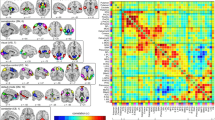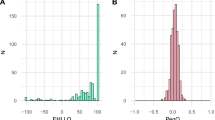Abstract
Resting state electroencephalography (EEG) during eyes-closed and eyes-open conditions is widely used to evaluate brain states of healthy populations and brain dysfunctions in clinical conditions. Although several results have been obtained by measuring these brain activities in humans, it remains unclear whether the same results can be replicated in animals, i.e., whether the physiological properties revealed by these findings are phylogenetically conserved across species. In the present study, we describe a paradigm for recording resting state EEG activities during eyes-closed and eyes-open conditions from rats, and investigated the differences between eyes-closed and eyes-open conditions for humans and rats. We found that compared to the eyes-open condition, human EEG spectral amplitude in the eyes-closed condition was significantly higher at 8–12 Hz and 18–22 Hz in the occipital region, but significantly lower at 18–22 Hz and 30–100 Hz in the frontal region. In contrast, rat EEG spectral amplitude was significantly higher in the eyes-closed condition than in the eyes-open condition at 1–4 Hz, 8–12 Hz, and 13–17 Hz in the frontal-central region. In both species, the 1/f-like power spectrum scaling of resting state EEG activities was significantly higher in the eyes-closed condition than in the eyes-open condition at parietal-occipital and frontal regions. These results provided a neurophysiological basis for future translational studies from experimental animal findings to human psychophysiology, since the validity of such translation critically relies on a well-established experimental paradigm and a carefully-examined signal characteristic to bridge the gaps across different species.








Similar content being viewed by others
References
Babiloni C, Pistoia F, Sarà M et al (2010) Resting state eyes-closed cortical rhythms in patients with locked-in-syndrome: an EEG study. Clin Neurophysiol 121:1816–1824. https://doi.org/10.1016/j.clinph.2010.04.027
Barry RJ, De Blasio FM (2017) EEG differences between eyes-closed and eyes-open resting remain in healthy ageing. Biol Psychol 129:293–304. https://doi.org/10.1016/j.biopsycho.2017.09.010
Barry RJ, Clarke AR, Johnstone SJ et al (2007) EEG differences between eyes-closed and eyes-open resting conditions. Clin Neurophysiol 118:2765–2773. https://doi.org/10.1016/j.clinph.2007.07.028
Bazanova O (2012) Comments for current interpretation EEG alpha activity: a review and analysis. J Behav Brain Sci 02:239–248. https://doi.org/10.4236/jbbs.2012.22027
Berger H (1929) Über das Elektrenkephalogramm des Menschen. Arch Psychiatr Nervenkrankh 87:527–570. https://doi.org/10.1007/BF01797193
Boĭtsova IA, Dan’ko SG (2010) EEG changes in comparison of rest states with open and closed eyes in complete darkness. Fiziol Cheloveka 36:138–141
Burn CC (2008) What is it like to be a rat? Rat sensory perception and its implications for experimental design and rat welfare. Appl Anim Behav Sci 112:1–32. https://doi.org/10.1016/j.applanim.2008.02.007
Buzsáki G (2006) Rhythms of the brain. Oxford University Press, New York
Buzsáki G, Anastassiou CA, Koch C (2012) The origin of extracellular fields and currents—EEG, ECoG, LFP and spikes. Nat Rev Neurosci 13:407–420. https://doi.org/10.1038/nrn3241
Buzsáki G, Logothetis N, Singer W (2013) Scaling brain size, keeping timing: evolutionary preservation of brain rhythms. Neuron 80(3):751–764
Chen ACN, Feng W, Zhao H et al (2008) EEG default mode network in the human brain: spectral regional field powers. NeuroImage 41:561–574. https://doi.org/10.1016/j.neuroimage.2007.12.064
Delorme A, Makeig S (2004) EEGLAB: an open source toolbox for analysis of single-trial EEG dynamics including independent component analysis. J Neurosci Methods 134:9–21. https://doi.org/10.1016/j.jneumeth.2003.10.009
Diamant E (2008) Unveiling the mystery of visual information processing in human brain. Brain Res 1225:171–178. https://doi.org/10.1016/j.brainres.2008.05.017
Falahpour M, Chang C, Wong CW, Liu TT (2018) Template-based prediction of vigilance fluctuations in resting-state fMRI. NeuroImage 174:317–327. https://doi.org/10.1016/j.neuroimage.2018.03.012
Feige B, Scheffler K, Esposito F et al (2005) Cortical and subcortical correlates of electroencephalographic alpha rhythm modulation. J Neurophysiol 93:2864–2872. https://doi.org/10.1152/jn.00721.2004
Gale A, Coles M, Boyd E (1971) Variation in visual input and the occipital EEG: II. Psychon Sci 23:99–100. https://doi.org/10.3758/BF03336026
Goldman RI, Stern JM, Engel J, Cohen MS (2002) Simultaneous EEG and fMRI of the alpha rhythm. NeuroReport 13:2487–2492. https://doi.org/10.1097/01.wnr.0000047685.08940.d0
Graimann B, Huggins JE, Levine SP, Pfurtscheller G (2002) Visualization of significant ERD/ERS patterns in multichannel EEG and ECoG data. Clin Neurophysiol 113:43–47. https://doi.org/10.1016/S1388-2457(01)00697-6
Härdle W, Gasser T, Bächer P (1984) EEG-responsiveness to eye opening and closing in mildly retarded children compared to a control group. Biol Psychol 18:185–199. https://doi.org/10.1016/0301-0511(84)90002-4
Hardmeier M, Hatz F, Bousleiman H et al (2014) Reproducibility of functional connectivity and graph measures based on the phase lag index (PLI) and weighted phase lag index (wPLI) derived from high resolution EEG. PLoS ONE 9:e108648. https://doi.org/10.1371/journal.pone.0108648
Hu L, Iannetti GD (2019) Neural indicators of perceptual variability of pain across species. Proc Natl Acad Sci. https://doi.org/10.1073/pnas.1812499116
Hu L, Xiao P, Zhang ZG et al (2014) Single-trial time–frequency analysis of electrocortical signals: baseline correction and beyond. NeuroImage 84:876–887. https://doi.org/10.1016/j.neuroimage.2013.09.055
Hu L, Xia XL, Peng WW et al (2015) Was it a pain or a sound? Across-species variability in sensory sensitivity. Pain 156:2449–2457. https://doi.org/10.1097/j.pain.0000000000000316
Jin QQ, Wu GQ, Peng WW et al (2018) Somatotopic representation of second pain in the primary somatosensory cortex of humans and rodents. J Neurosci 38:5538–5550. https://doi.org/10.1523/JNEUROSCI.3654-17.2018
Jung TP, Makeig S, Stensmo M, Sejnowski TJ (1997) Estimating alertness from the EEG power spectrum. IEEE Trans Biomed Eng 44:60–69. https://doi.org/10.1109/10.553713
Keune PM, Hansen S, Weber E et al (2017) Exploring resting-state EEG brain oscillatory activity in relation to cognitive functioning in multiple sclerosis. Clin Neurophysiol 128:1746–1754. https://doi.org/10.1016/j.clinph.2017.06.253
Khanna A, Pascual-Leone A, Michel CM, Farzan F (2015) Microstates in resting-state EEG: current status and future directions. Neurosci Biobehav Rev 49:105–113. https://doi.org/10.1016/j.neubiorev.2014.12.010
Klimesch W (2013) An algorithm for the EEG frequency architecture of consciousness and brain body coupling. Front Hum Neurosci 7:766. https://doi.org/10.3389/fnhum.2013.00766
Lau TM, Gwin JT, McDowell KG, Ferris DP (2012) Weighted phase lag index stability as an artifact resistant measure to detect cognitive EEG activity during locomotion. J Neuroeng Rehabil 9:47. https://doi.org/10.1186/1743-0003-9-47
Lei X, Zhao Z, Chen H (2013) Extraversion is encoded by scale-free dynamics of default mode network. NeuroImage 74:52–57. https://doi.org/10.1016/j.neuroimage.2013.02.020
Lei X, Wang Y, Yuan H, Chen A (2015) Brain scale-free properties in awake rest and NREM sleep: a simultaneous EEG/fMRI study. Brain Topogr 28:292–304. https://doi.org/10.1007/s10548-014-0399-x
Lim J, Quevenco F-C, Kwok K (2013) EEG alpha activity is associated with individual differences in post-break improvement. NeuroImage 76:81–89. https://doi.org/10.1016/j.neuroimage.2013.03.018
Linkenkaer-Hansen K, Nikouline VV, Palva JM, Ilmoniemi RJ (2001) Long-range temporal correlations and scaling behavior in human brain oscillations. J Neurosci 21:1370–1377
Lomas T, Ivtzan I, Fu CHY (2015) A systematic review of the neurophysiology of mindfulness on EEG oscillations. Neurosci Biobehav Rev 57:401–410. https://doi.org/10.1016/j.neubiorev.2015.09.018
Lopes DS, Storm VL (1977) The cortical source of the alpha rhythm. Neurosci Lett 6:237–241. https://doi.org/10.1016/0304-3940(77)90024-6
Luppi M, Al-Jahmany AA, Del Vecchio F et al (2017) Wake-sleep and cardiovascular regulatory changes in rats made obese by a high-fat diet. Behav Brain Res 320:347–355. https://doi.org/10.1016/j.bbr.2016.12.024
Michel CM, Koenig T (2018) EEG microstates as a tool for studying the temporal dynamics of whole-brain neuronal networks: a review. NeuroImage 180:577–593. https://doi.org/10.1016/j.neuroimage.2017.11.062
Michels L, Muthuraman M, Lüchinger R et al (2013) Developmental changes of functional and directed resting-state connectivities associated with neuronal oscillations in EEG. NeuroImage 81:231–242. https://doi.org/10.1016/j.neuroimage.2013.04.030
Miller KJ, Sorensen LB, Ojemann JG, den Nijs M (2009) Power-law scaling in the brain surface electric potential. PLoS Comput Biol 5:e1000609. https://doi.org/10.1371/journal.pcbi.1000609
Miraglia F, Vecchio F, Bramanti P, Rossini PM (2016) EEG characteristics in “eyes-open” versus “eyes-closed” conditions: small-world network architecture in healthy aging and age-related brain degeneration. Clin Neurophysiol 127:1261–1268. https://doi.org/10.1016/j.clinph.2015.07.040
Moosmann M, Ritter P, Krastel I et al (2003) Correlates of alpha rhythm in functional magnetic resonance imaging and near infrared spectroscopy. NeuroImage 20:145–158. https://doi.org/10.1016/S1053-8119(03)00344-6
Narayanan B, O’Neil K, Berwise C et al (2014) Resting state electroencephalogram oscillatory abnormalities in schizophrenia and psychotic bipolar patients and their relatives from the bipolar and schizophrenia network on intermediate phenotypes study. Biol Psychiatry 76:456–465. https://doi.org/10.1016/j.biopsych.2013.12.008
Neto E, Allen EA, Aurlien H et al (2015) EEG spectral features discriminate between Alzheimer’s and vascular dementia. Front Neurol 6:25. https://doi.org/10.3389/fneur.2015.00025
Oostenveld R, Fries P, Maris E, Schoffelen J-M (2011) FieldTrip: open source software for advanced analysis of MEG, EEG, and invasive electrophysiological data. Comput Intell Neurosci 2011:156869. https://doi.org/10.1155/2011/156869
Ortiz E, Stingl K, Münßinger J et al (2012) Weighted Phase Lag Index and graph analysis: preliminary investigation of functional connectivity during resting state in children. Comput Math Methods Med 2012:1–8. https://doi.org/10.1155/2012/186353
Peng W, Xia X, Yi M et al (2018) Brain oscillations reflecting pain-related behavior in freely moving rats. Pain 159:106–118. https://doi.org/10.1097/j.pain.0000000000001069
Petersen CCH (2007) The functional organization of the barrel cortex. Neuron 56:339–355. https://doi.org/10.1016/j.neuron.2007.09.017
Pritchard WS (1992) The brain in fractal time: 1/F-like power spectrum scaling of the human electroencephalogram. Int J Neurosci 66:119–129. https://doi.org/10.3109/00207459208999796
Sánchez-López A, Silva-Pérez M, Escudero M (2018) Temporal dynamics of the transition period between nonrapid eye movement and rapid eye movement sleep in the rat. Sleep. https://doi.org/10.1093/sleep/zsy121
Schaeffel F (2009) Processing of information in the human visual system. Wiley-VCH, Weinheim
Schoenberg PLA, Ruf A, Churchill J et al (2018) Mapping complex mind states: EEG neural substrates of meditative unified compassionate awareness. Conscious Cogn 57:41–53. https://doi.org/10.1016/j.concog.2017.11.003
Shaw FZ, Chen RF, Yen CT (2001) Dynamic changes of touch- and laser heat-evoked field potentials of primary somatosensory cortex in awake and pentobarbital-anesthetized rats. Brain Res 911:105–115
Tangermann M, Müller K-R, Aertsen A et al (2012) Review of the BCI competition IV. Front Neurosci 6:55. https://doi.org/10.3389/fnins.2012.00055
Tenke CE, Kayser J (2012) Generator localization by current source density (CSD): implications of volume conduction and field closure at intracranial and scalp resolutions. Clin Neurophysiol 123:2328–2345. https://doi.org/10.1016/j.clinph.2012.06.005
Teramoto H, Morita A, Ninomiya S et al (2016) Relation between resting state front-parietal EEG coherence and executive function in Parkinson’s disease. Biomed Res Int 2016:2845754. https://doi.org/10.1155/2016/2845754
Vinck M, Oostenveld R, van Wingerden M et al (2011) An improved index of phase-synchronization for electrophysiological data in the presence of volume-conduction, noise and sample-size bias. NeuroImage 55:1548–1565. https://doi.org/10.1016/j.neuroimage.2011.01.055
Volavka J, Matoušek M, Roubíček J (1967) Mental arithmetic and eye opening. An EEG frequency analysis and GSR study. Electroencephalogr Clin Neurophysiol 22:174–176. https://doi.org/10.1016/0013-4694(67)90158-7
Wang J, Fang Y, Wang X et al (2017) Enhanced gamma activity and cross-frequency interaction of resting-state electroencephalographic oscillations in patients with Alzheimer’s disease. Front Aging Neurosci 9:243. https://doi.org/10.3389/fnagi.2017.00243
White RS, Siegel SJ (2016) Cellular and circuit models of increased resting-state network gamma activity in schizophrenia. Neuroscience 321:66–76. https://doi.org/10.1016/j.neuroscience.2015.11.011
Woltering S, Jung J, Liu Z, Tannock R (2012) Resting state EEG oscillatory power differences in ADHD college students and their peers. Behav Brain Funct 8:60. https://doi.org/10.1186/1744-9081-8-60
Wyckoff SN, Sherlin LH, Ford NL, Dalke D (2015) Validation of a wireless dry electrode system for electroencephalography. J Neuroeng Rehabil 12:95. https://doi.org/10.1186/s12984-015-0089-2
Xia XL, Peng WW, Iannetti GD, Hu L (2016) Laser-evoked cortical responses in freely-moving rats reflect the activation of C-fibre afferent pathways. NeuroImage 128:209–217. https://doi.org/10.1016/j.neuroimage.2015.12.042
Yao D, Wang L, Oostenveld R et al (2005) A comparative study of different references for EEG spectral mapping: the issue of the neutral reference and the use of the infinity reference. Physiol Meas 26:173–184. https://doi.org/10.1088/0967-3334/26/3/003
Yuan XS, Wang L, Dong H et al (2017) Striatal adenosine A2A receptor neurons control active-period sleep via parvalbumin neurons in external globus pallidus. Elife. https://doi.org/10.7554/elife.29055
Acknowledgements
This work was supported by the National Natural Science Foundation of China (Nos. 31671141, 31822025), the Informatization Special Project of Chinese Academy of Sciences (No. XXH13506-306), and the Scientific Foundation project of Institute of Psychology, Chinese Academy of Sciences (No. Y6CX021008). The funders had no role in study design, data collection, data analysis, decision to publish, or preparation of the manuscript. The authors have declared that no competing interests exist.
Author information
Authors and Affiliations
Corresponding author
Additional information
Handling Editor: Micah M. Murray
Publisher's Note
Springer Nature remains neutral with regard to jurisdictional claims in published maps and institutional affiliations.
Electronic supplementary material
Below is the link to the electronic supplementary material.
Supplementary material 2 (MOV 14214 kb)
Supplementary material 3 (MOV 18695 kb)
Supplementary material 4 (MOV 16014 kb)
Rights and permissions
About this article
Cite this article
Zhang, F., Wang, F., Yue, L. et al. Cross-Species Investigation on Resting State Electroencephalogram. Brain Topogr 32, 808–824 (2019). https://doi.org/10.1007/s10548-019-00723-x
Received:
Accepted:
Published:
Issue Date:
DOI: https://doi.org/10.1007/s10548-019-00723-x




